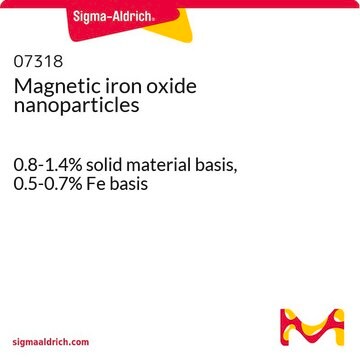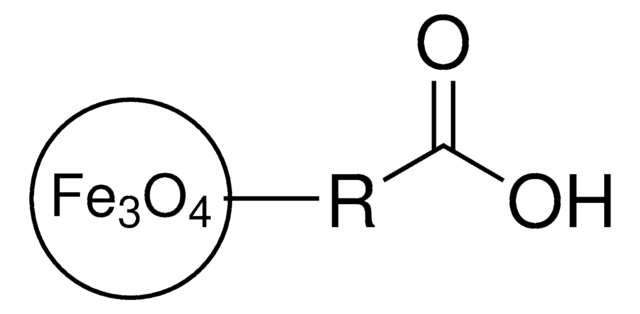This product is not tested for density. The final concentration of the solution is 5 mg/mL nanoparticles in toluene. However, the density of the iron oxide nanoparticles is ~5.2 g/cm3. The density of 0.865 g/ml listed on the product page is in reference to the toluene, only.
700312
Iron oxide(II,III), magnetic nanoparticles solution
10 nm avg. part. size, 5 mg/mL in toluene
Sinônimo(s):
Magnetic iron oxide nanocrystals, Magnetite, Superparamagnetic iron oxide nanoparticles
Selecione um tamanho
Selecione um tamanho
About This Item
Produtos recomendados
Formulário
nanoparticles
solution
Nível de qualidade
concentração
5 mg/mL in toluene
magnetização
>45 emu/g (at ambient temperature under 4500 Oe)
Tamanho médio da partícula
10 nm
tamanho de partícula
9-11 nm (TEM; conforms)
densidade
0.865 g/mL at 25 °C
cadeia de caracteres SMILES
O=[Fe].O=[Fe]O[Fe]=O
InChI
1S/3Fe.4O
chave InChI
SZVJSHCCFOBDDC-UHFFFAOYSA-N
Procurando produtos similares? Visita Guia de comparação de produtos
Descrição geral
It contains <1.0% oleic acid stabilizing ligands.
Aplicação
Palavra indicadora
Danger
Frases de perigo
Declarações de precaução
Classificações de perigo
Aquatic Chronic 3 - Asp. Tox. 1 - Flam. Liq. 2 - Repr. 2 - Skin Irrit. 2 - STOT RE 2 - STOT SE 3
Órgãos-alvo
Central nervous system
Código de classe de armazenamento
3 - Flammable liquids
Classe de risco de água (WGK)
WGK 3
Ponto de fulgor (°F)
45.0 °F
Ponto de fulgor (°C)
7.2 °C
Equipamento de proteção individual
Eyeshields, Faceshields, Gloves, type ABEK (EN14387) respirator filter
Escolha uma das versões mais recentes:
Já possui este produto?
Encontre a documentação dos produtos que você adquiriu recentemente na biblioteca de documentos.
Os clientes também visualizaram
Artigos
Professor Hui Mao explores the use of superparamagnetic iron oxide nanoparticles (INOPs) that offer an alternate contrast-enhancing mechanism.
Prof. Yadong Yin discusses various synthesis methods of magnetite nanocrystals and their applications in different fields.
Magnetic materials find diverse applications from data storage to renewable energy.
-
What is the density of the product ( super paramagnetic iron oxide NP in toluene)
1 answer-
Helpful?
-
-
What is the coating thickness of oleic acid on product number 700312, 700320, and 700304, Iron oxide(II,III), magnetic nanoparticles solution?
1 answer-
The suppliers of the magnetic iron oxide nanoparticles in toluene have indicated that the particles are essentially coated with a monolayer of oleic acid. Since the oleic acid is a long chain hydrocarbon there can exist some folding and irregular structure on the surface. The suppliers estimate that one should add 1-2 nm to the particle size due to the presence of the oleic acid coating. From this, 1.5 nm is the closest approximation of coating thickness as provided by our suppliers.
Helpful?
-
-
What method is used to determine the size of the particles in Product 700312, Iron oxide?
1 answer-
TEM used to check particle size. Light Scattering or similar methods are not utilized.
Helpful?
-
-
What is the purpose of the oleic acid in Product 700312, Iron oxide? Can it be removed?
1 answer-
Per the manufacturer, the oleic acid allows the iron oxide nanoparticles to be soluble in the solvent (i.e. toluene).
Helpful?
-
-
How should a sample of the Iron oxide(II,III), magnetic nanoparticles solution in toluene be prepared for analysis by transmission electron microscopy (TEM)?
1 answer-
The particle size is determined by TEM.If the solution as provided is not diluted, a superlattice of multilayer nanocrystals will form on the grid, appearing to be an aggregate. The solution can be diluted with the same solvent that it was shipped in (toluene). A solution diluted to 0.1-0.5 mg/mL should be concentrated enough to get a nice picture. One drop per grid should be sufficient. (Since the solution is provided at a concentration of 5 mg/mL, this would be a 10- to 50-fold dilution.)After applying the sample to the grid, a drying time of a minimum of 10-15 minutes is recommended.After performing several successful dilutions and getting good results, the analyst will get a feel for the correct dilution just by judging the color and darkness of the diluted sample. If you see lone isolated dots in the TEM, then your sample is too dilute. If you cannot distinguish separate particles, it is too concentrated. Good record keeping will help to zero in on the best dilution factor for the type of picture that you want.
Helpful?
-
-
How is the magnetization of Product 700312, Iron oxide, determined?
1 answer-
Per the supplier, the magnetization is determined by using a Magnetic Susceptibility Balance.
Helpful?
-
-
What is the Department of Transportation shipping information for this product?
1 answer-
Transportation information can be found in Section 14 of the product's (M)SDS.To access the shipping information for this material, use the link on the product detail page for the product.
Helpful?
-
Active Filters
Nossa equipe de cientistas tem experiência em todas as áreas de pesquisa, incluindo Life Sciences, ciência de materiais, síntese química, cromatografia, química analítica e muitas outras.
Entre em contato com a assistência técnica





